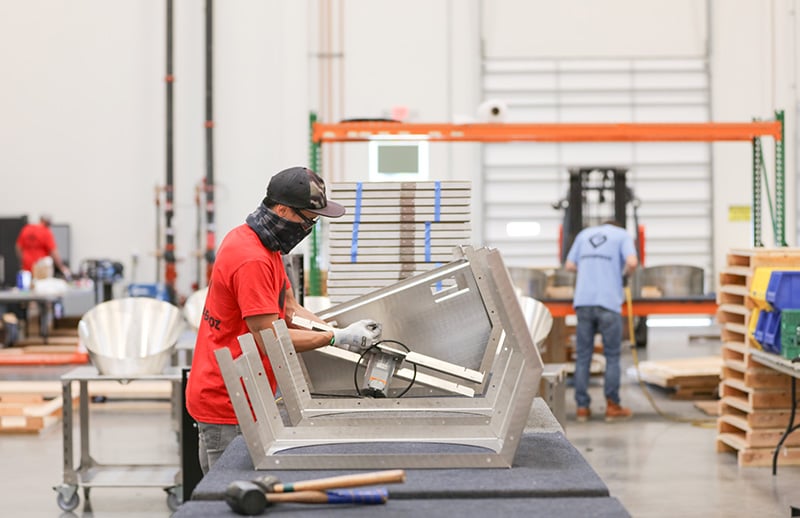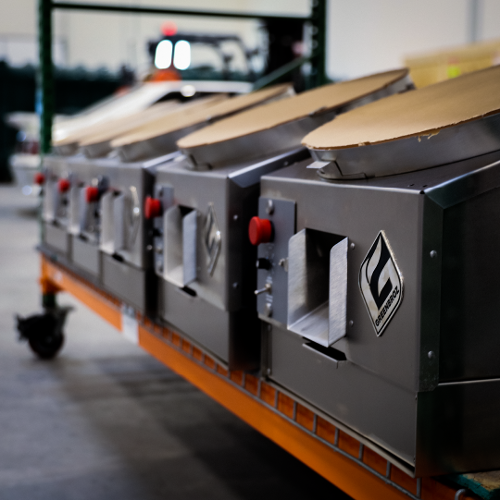The Ultimate Guide to Cannabis Equipment Maintenance
In the world of cannabis cultivation, your equipment is your best friend. Keeping it in pristine condition isn't just about prolonging its lifespan;...

With hazy legal status and a thriving illicit market, the cannabis industry has a responsibility to voluntarily adopt green manufacturing practices. Currently, producing just two pounds of cannabis creates about 10,000 pounds of carbon dioxide, and the industry as a whole produces over 16 million pounds of carbon dioxide each year with a real impact on global warming. It is vital for both new cannabis entrepreneurs and industry strongholds to take an active interest in the development of eco-friendly policies. Even in states with recreationally legalized cannabis, the illicit market grows significant quantities of unregulated plants — frequently on nationally-protected lands with harmful production practices.
Going green can help cannabis build an even more exciting future. The legal cannabis industry endures complicated, evolivng, and often conflicting regulations. The standardization of the cannabis industry’s environmental impact has the potential to create opportunities for more people to enter the legal market, as well as lead the agricultural industry in sustainable practices. On an individual level, businesses that engage in practices like regenerative agriculture, responsible water sourcing, and renewable energy help reduce their overall costs and optimize product quality. Whether you are a budding entrepreneur or an experienced business owner, going green through green manufacturing processes can give you a competitive advantage at the retail counter.

The cost savings, operational efficiency, and environmental impact of going green are undeniably beneficial. Sustainable, environmentally-conscious business practices have both immediate and long-term benefits. As an industry operating largely outside federal regulation, cannabis has a responsibility to regulate itself. When the federal government eventually legalizes cannabis, businesses already operating in the most sustainable and safest ways possible will have a significant advantage on their bottom line. Businesses from all corners of the consumer industry have exemplified the benefits of sustainable operation.
The National Institute of Standards and Technology (NIST) encourages businesses to go green for numerous reasons, including the ability to conserve energy, lower carbon emissions, attract new customers, receive tax credits, spur innovation, and produce green products that have a positive impact on society as a whole. A cannabis business that opts for energy-efficient machinery, packaging, and power will benefit for many years from its initial investment. In Oregon, a candy company called American Licorice saved $48,000 in one year after implementing a recycled materials program for all its industrial waste.
Across the country, in Massachusetts, the state’s cannabis control commission established some of the country’s strictest regulations to encourage energy efficiency by cultivators and manufacturers. Massachusetts-based cannabis company, Solar Therapeutics has worked to do more than comply with the regulations. The company introduced an energy-efficient program that cuts both its energy use and its monthly electricity costs by 50 percent.
While the cannabis industry’s participation in sustainable operation programs is highly beneficial, there are a number of simple, small-scale practices that help reduce environmental impact and save money. Cannabis businesses can start making environmentally conscious decisions now by simply turning off machinery whenever it is not in use, fixing any leaks, air-sealing their facilities, and switching to energy-efficient lighting. Small, continuous efforts can collectively make a big difference.
While going green makes sense for the cannabis industry, there are numerous challenges that must be addressed by both cultivators and manufacturers. The cannabis industry can reduce its negative impact on the environment in every stage from planting to packaging.
The cannabis industry produces significant direct emissions during both cultivation and manufacturing processes, including those from the plants themselves. Indoor cannabis farms can produce additional harmful emissions in large quantities when they burn fossil fuels, and processing facilities must be mindful of contaminants released during cannabis extraction. Carbon filtration systems are commonly used and recommended for cannabis businesses that need to reduce odors and harmful emissions. Luckily, carbon filters are simple to install as well as being effective and reliable. These filters are typically most effective when positioned at the highest point in the grow space of environmentally-controlled facilities. Ozone generators, mineral filters, biofilters, and closed-loop extraction systems can also help the cannabis industry reduce the toxic emissions it releases into the air.
All facets of the cannabis industry can do their part to achieve energy efficiency. While installing solar panels at a physical site can drastically reduce a company’s energy consumption and associated costs, purchasing a renewable energy system is not the only solution. There are smaller-scale actions that everyone in the industry can take. Every business can make sure they turn off equipment when it is not being used, automate high-energy equipment, optimize their space utilization, and opt for LED lighting and efficient HVAC systems. Indoor cultivators can also employ best practices like vertical stacking, mobile racking, and automated temperature and humidity control. A traditional HVAC and lighting system can make up almost half of a facility’s operating costs, while energy-efficient alternatives can reduce operating costs by 30 percent.
When cannabis is federally legalized, the industry will be tied to a wide array of environmental regulations and production standardizations. However, the market is already demanding long-lasting products and rejecting single-use plastics. Millennials, who currently make up the largest generation in the United States population, are willing to pay more for environmentally friendly, organic, and socially-conscious products. Smart cannabis businesses are working to integrate reusable, refillable, and compostable containers into their production models. Other cannabis entrepreneurs are also implementing packaging “take-back” programs at retail locations. These types of programs help demonstrate corporate responsibility to the public and encourage consumers to return to a retail site that’s supporting local environmental efforts by reducing landfill waste. In fact, GreenBroz machines are 98% recyclable, meaning that their equipment and spare parts won’t be sitting in landfills in 100 years.
There are also environmentally-conscious choices to be made in supply chain management. Many buyers are partial to products produced in and sourced from the United States. Inexpensive imports are often accompanied by a larger carbon footprint and offshore supply chains are not subject to the same regulations as most domestic operations. Supply chains account for up to four times the harmful emissions of a company’s direct operations, and many major companies do not receive climate data from their suppliers. Choosing suppliers that disclose their environmental impact data can help the cannabis industry save money and emerge as a leader in green manufacturing.
It is also important for cannabis businesses to be aware of the state laws where the business operates. In California, the Buy Clean Act of 2017 required all suppliers working with California businesses to purchase goods with “embodied emissions” below a legally stipulated level. California also offers heavy energy users price reductions on trade permits to offset the costs of ethical supply sources like local, sustainable businesses. The path to sustainable manufacturing requires a good deal of planning. Smart cannabis companies do their research so they know what is required, what is available, and what is possible.
For cultivators, the waste and harmful emissions produced in the growth and harvesting processes can be concerning. While all cultivators should develop and continually assess a land-use plan, there are different challenges associated with outdoor and indoor cannabis farms. Outdoor cannabis farms must meticulously consider geographic location, soil health, erosion, pesticides, runoff, and appropriate cultivation rotations. Indoor farms must decide whether to grow their plants with a hydroponic system or in soil. And any cultivator who grows cannabis in soil should work to build and maintain soil organic matter (SOM), which is the ideal concentration of nitrogen, phosphorus, and potassium. Tracking and maximizing the health of the soil allows cultivators to grow high-quality products in large capacities with little harm to the environment.
It’s a reality that plant waste makes up a large portion of the cannabis industry’s environmental impact. Fortunately, the right processing equipment including the Alchemist line of trichome extractors allows businesses to turn potentially wasted trim into valuable kief packed with cannabinoid-rich trichomes without the use of any harmful solvents. When paired with an eco-friendly dry trimmer that manicures flowers instead of turning them into golf balls, businesses end up with leftover plant waste through an incredibly efficient process.
Unfortunately, literal tons of plant waste still ends up in landfills, and regulations surrounding its production and disposal makes cannabis difficult to successfully compost. Cannabis entrepreneurs have developed a best practice to ameliorate the plant waste sent to landfills. Cultivators can manage leftover plant material using on-site anaerobic digestion, which uses plant waste to generate and capture methane, carbon dioxide, and fertilizer. Each of these byproducts can be reused in cultivation and extraction processes. This innovative solution provides a complete diversion of plant waste from landfills.
As the cannabis industry continues to grow, it requires exponentially more clean water to keep up with demand. Growing cannabis affects both the quality and the available quantity of this rapidly dwindling natural resource. It is important to seek out and comply with all government regulations related to water use. The location of the farm should be carefully considered according to its surrounding water sources. This is especially important for businesses in the Western United States, where water rights are politically contentious and complicated.
Anyone in the cannabis industry who is building a facility can benefit from a water management plan and the incorporation of a value engineering approach, which will simultaneously reduce waste and costs. Once in operation, a facility will benefit from monitoring and tracking all of its water use. Testing water quality is also an important part of regenerative agriculture and processing green. Many cannabis businesses reduce their water waste by opting for drip irrigation systems, automating water systems, recycling water, and testing and appropriately treating used water to provide their plants with the best nutrients possible.
When standardized regulations are implemented in the cannabis industry on the local, state, and federal levels, sustainable cannabis practices will have the opportunity to truly flourish. With the eventual federal legalization of cannabis and its compounds, the industry will have access to the U.S. Department of Agriculture’s development assistance programs, loan assistance through the Small Business Administration, and funding from the Environmental Protection Agency for education, research, and technical advancement. This quickly growing industry must remain ready to use its existing infrastructure in collaboration with new technologies to successfully enable environmental efficiency.
Until the cannabis industry has access to the regulation and funding provided by federal institutions, both cultivators and manufacturers should engage with the relevant voluntary certification programs. There is a wealth of power, potential savings, and environmental preservation in collective voluntary regulations. Entrepreneurs must work together now to create a cannabis industry that is eco-friendly, safe, and economically prosperous for generations to come. Choosing to regulate and standardize now can properly situate cannabis businesses for another big wave of innovation upon its federal legalization. Whether it's water, air, soil, or waste, cannabis has the power to lead the agricultural industry in sustainable practices. It is imperative that regulations protect the environment under the direction of scientific understanding, while simultaneously creating opportunities for entrepreneurs to join the industry and achieve long-term sustainability in cannabis.
Never miss a blog posting or exclusive shop deal!

In the world of cannabis cultivation, your equipment is your best friend. Keeping it in pristine condition isn't just about prolonging its lifespan;...

In Humboldt County's green expanses, Jonah Carrington is changing the cannabis game with the GreenBroz Model G Precision Grinder. From his Santa...

Cannabis has come a long way, from black market only to decriminalization, and being legalized in one form or another is just about every state. The...